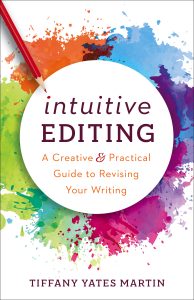Momentum and Pace—Giving Readers a Satisfying Ride
Today’s guest post is by Tiffany Yates Martin.
Imagine you’re trying to get to LA on a cross-country road trip and the driver keeps doubling back, or going on winding detours, or stopping on the side of the road to just hang out. And when you finally do get moving toward your destination, he does ninety miles an hour on the entire journey and never lets up—or crawls along at twenty mph the whole … way … there.
That’s momentum and pace, and when either element isn’t working well, readers are in for a frustrating journey. Momentum, as the engine of story, should be constant—the vehicle should always be heading toward the final destination.
But pace—how fast it gets there—can and usually should vary throughout.
Though often these terms are used interchangeably, momentum and pace aren’t quite the same thing. You can think of momentum is a function of story and pace as a function of scene.
Momentum is the story’s steady push toward its destination, the answer to the central story question that the reader is invested in finding out: Will Harry Potter defeat Voldemort; can Sherlock solve the crime; how does Stella get her groove back?
Pace is the rhythm of each step on the journey.
Authors are often too close to their stories to spot whether they’re using each of these powerful storytelling elements as effectively as possible in their own work.
You know what’s coming and you’re filling in the blanks, so to you perhaps that slide into a rest area feels like a thrilling slow build of conflict before the big pileup up ahead—whereas to readers it might stop momentum cold and cause the pace to drag when they want it to be clipping, giving them an excuse to put the book down … and maybe not pick it back up.
But it’s possible to gain enough objective distance to determine whether you’re using both story elements as effectively as possible by looking at a few key areas in each.
Momentum
Although momentum pertains to the whole story, its building blocks are individual scenes, and you can check whether you maintain consistent story momentum by asking yourself two key questions about each one:
- Is this scene essential to move the story forward?
- Is it the most effective way of doing so?
A scene is essential for propelling the story if it accomplishes at least one of the following:
- Advancing the plot
- Advancing the character arc
- Raising stakes
- Providing essential information
But the most engaging stories multitask—meaning scenes layer in more than one of these purposes.
Here’s an example: In Gillian Flynn’s Gone Girl, not long after Nick’s wife, Amy, is discovered missing and the police begin to investigate Nick as a suspect, the investigator accompanies Nick into his office—where they discover an envelope marked “Second Clue” that Nick is obliged to open and read with the detective. It contains both a clue to Amy’s disappearance and a love note for Nick—despite Nick’s having told the detective they’d been having marital problems. The investigator disingenuously points out a pair of women’s underwear flung in a corner of Nick’s office and waits for an explanation; Nick lies and says the panties are his wife’s; he tries to take them, but the officer slides them into an evidence bag.
Flynn creates a lot of story momentum in this brief two-page scene by combining all the elements above. The discovery of the new clue as well as the other incriminating evidence is essential information and certainly advances the plot. It also raises stakes, catching Nick in lies and making him look even more suspicious. It even furthers Nick’s character arc, as we see him backed into a corner and digging himself a deeper hole.
Every scene doesn’t have to be quite this layered, but one reason Gone Girl was such a smash is that it grabbed the reader and didn’t let go. Once we climb in for the ride, Flynn never lets us out of the car.
Once you’ve made sure every single scene has a key role to play in moving the story forward, evaluating whether it’s the most effective way of doing so—how efficiently and well it moves the action forward—involves finding the balance between what to add and what to take away:
What to Add:
- Fill in the gaps: Readers need enough information to ground us in the story, keep us invested, and advance the plot. If we’re left wondering what’s happening or feeling confused or left behind, story momentum stops cold.
- Make sure the meat is on the plate: Key developments should be on the page, not happening “offstage” and summed up for readers secondhand. If Flynn had simply described the above essential scene in Nick’s POV after the fact, it would have lacked the punch and propulsion it lends to the narrative as readers experience it directly.
- Put the characters in the action: Momentum is the engine and plot is the road, but your protagonists are the drivers; readers want to see them driving the story. Keep momentum strong by ensuring your characters are directly propelling the action.
- Layer in tension and suspense: The Gone Girl scene above is rife with both, as readers wonder whether Nick is guilty or will be caught (suspense) and each new discovery and beat creates friction and conflict between him and the investigator (tension). No matter your genre, both story elements serve to keep readers guessing, which keeps them turning the pages—which keeps momentum strong.
- Connect the dots: If a story skips over key developments—reactions to or fallout from important happenings, for instance, or key turning-point or choice-point moments—readers are left wondering how we got to certain points in the journey, and momentum stalls out. Make sure you orient readers with germane “connective tissue.”
- Check beginnings and endings: Both are crucial places to maintain momentum: Make sure you begin every chapter and scene with a hook that compels us onward, and leave each one with an uncertainty, question, unresolved tension, mystery, etc., to propel us forward. And end the story where it ends; the most propulsive story can lose all its steam if it sputters on beyond the finish line.
What to Take Away:
- Eliminate redundancy: This is more than just repeated ideas or words; if a scene repeats a dynamic you already established in a previous scene, it’s idling the engine rather than moving the story down the road. In Gone Girl, for instance, we’ve already seen scenes that make Nick a possible suspect in his wife’s disappearance; what keeps the above scene from being repetitive is that it raises the stakes—a new dynamic.
- Don’t get lost in backstory: Characters don’t exist in a vacuum or spring into existence at the beginning of your story; backstory is essential, but how you incorporate it directly impacts momentum. Long flashbacks or explanation often yank readers out of the main story, stopping forward momentum dead. Think of this material as seasoning you sprinkle in little by little to add complexity, rather than dumping it in all at once.
- Don’t get lost in exposition: By the same token, don’t let momentum stall with swaths of inessential verbiage: common culprits are too much description, too much background, and too much character introspection. Keep the story moving forward, even as you lace in this essential context.
Pace
If momentum governs the impetus of the story as a whole, pace is a function of each individual scene.
Varying pace and using it intentionally will increase reader engagement and enjoyment. Sometimes the trip is most exhilarating when you’re flying down the road; sometimes you need to slow down and take in the scenery.
- Suit pace to genre: Different genres have different pace expectations—readers of literary fiction aren’t necessarily expecting pulse-pounding, page-turning action; thriller readers may grow bored if pace slows for more than a few pages.
- Suit pace to action: A high-tension chase scene should generally move at a fast clip. The lazy morning in bed after your hero and heroine finally get together may allow you to linger.

- Suit the pace to the mood. In general, a slow pace reflects a solemn tone, a peaceful mood, deep emotion or introspection, or respite. It can be effectively used for lower-urgency (but not necessarily low-stakes) scenes where you want to dig a little deeper; “sequel” scenes where your character may be reacting, reflecting, or regrouping; and resolution scenes (we enjoy seeing our hero relax a bit after all the hard work of achieving her goal). A faster pace is generally most effective in scenes involving a heightened sense of arousal, like fear, excitement, fury, etc. It helps drive scenes of danger, conflict, competition, suspense, pursuit, and often humor.
- Use pace unexpectedly. You can also use pace to layer in depth to a scene or character, for example by contrasting it with the mood, or between different characters in the same scene. A funeral that’s forced to lightning speed by the threat of rain, for instance, might be intentionally incongruously hilarious … or more tragic if a character feels cheated of the chance to properly honor his departed beloved. A love scene in which one character leisurely revels in the intimacy while another keeps rushing it says a lot about their relationship and respective characters. And a sharp shift to one slow moment in a fast-paced scene can add wonderful emphasis to that single beat.
- Pay attention to your prose: Long, meandering complex sentence structure sets a slower pace; short lines fly. The same applies to paragraph length. Multisyllabic words lend a more leisurely pace; single syllables speed it. And watch for “pace killers”—pace can get bogged down by overuse of dialogue tags, too much stage direction or description, info dumps or long chunks of backstory.
Sustaining steady momentum throughout your story and controlling and varying the pace are essential for compelling fiction. Together they keep readers invested and engaged in the journey and allow you to create the experience you want them to have.
Have you used any of these techniques in sustaining story momentum or setting pace in your own stories? Which ones have been most effective for your writing? What other ways do you orchestrate the reader’s experience of the journey of your stories?
 Tiffany Yates Martin has spent nearly thirty years as an editor in the publishing industry, working with major publishers and best-selling authors as well as newer writers, and is the author of Intuitive Editing: A Creative and Practical Guide to Revising Your Writing. She’s led workshops and seminars for conferences and writers’ groups across the country and is a frequent contributor to writers’ sites and publications. Visit her at www.foxprinteditorial.com, and connect on Facebook and Twitter.
Tiffany Yates Martin has spent nearly thirty years as an editor in the publishing industry, working with major publishers and best-selling authors as well as newer writers, and is the author of Intuitive Editing: A Creative and Practical Guide to Revising Your Writing. She’s led workshops and seminars for conferences and writers’ groups across the country and is a frequent contributor to writers’ sites and publications. Visit her at www.foxprinteditorial.com, and connect on Facebook and Twitter.
Featured image: Photo by Filip Mroz on Unsplash










Happy day! A virtual visit to one of my favourite writing sites, Live Write Thrive, AND find the lovely Tiffany Yates Martin here.
Waving to you guys from Australia,
x Jay